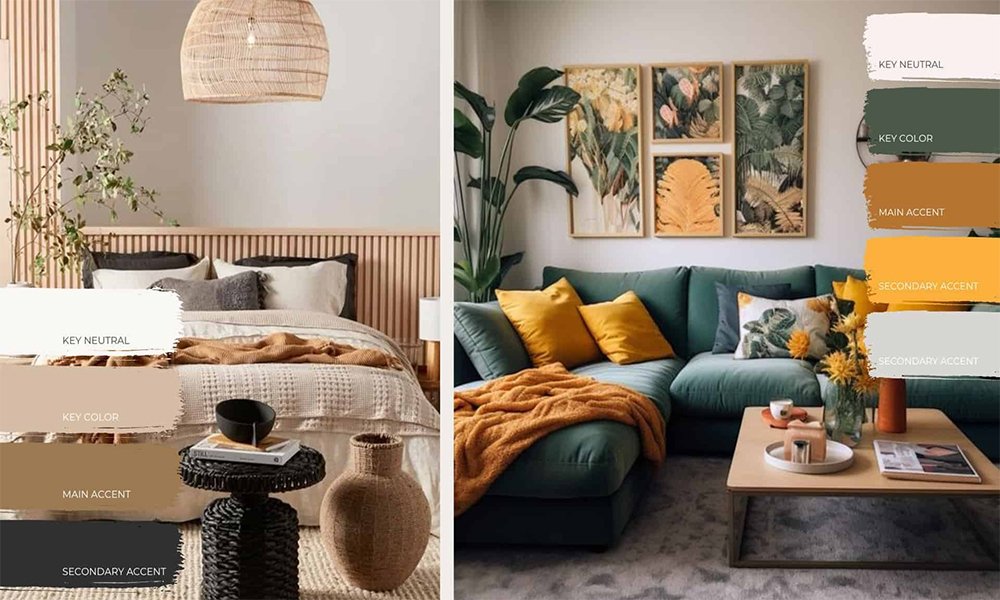Choosing the right color palette for your home can be both exciting and overwhelming. The colors you choose not only set the tone for your living space, but they can also affect your mood and feel in any room. Whether you’re painting an entire room or just want to refresh your existing decor, knowing how to choose the right color palette is key to creating a space that feels harmonious and inviting.
In this guide, we’ll break the process down into easy steps to help you find the perfect color palette for your home. Let’s dive in!
1. Consider the purpose of the room
Before you dive into colors, think about the function of the room. Different rooms have different color needs:
Living room: These are rooms where you spend a lot of time socializing, relaxing, and entertaining. Opt for colors that create a welcoming and cozy atmosphere, like warm neutrals, soft blues, or muted greens.
Bedrooms: The bedroom is your sanctuary, a place to relax and unwind. Choose calm and soothing colors like soft blue, lavender, or earth tones like beige and taupe.
Kitchens: The kitchen is often the heart of the home. In this area, lighter colors like bright yellow, white, or soft green can create a welcoming, energetic space.
Bathrooms: Small bathrooms can benefit from light, airy colors that make them appear larger, like white, pastel, or light gray.

2. Get inspiration from existing elements
If you already have furniture, artwork, or textiles in your home, let those elements guide your color choices. For example:
Furniture: If you have bold, colorful furniture, you may want to choose a more neutral palette for the walls to avoid clashing. On the other hand, if your furniture is neutral, you can be bolder with wall colors.
Artwork: A piece of art you love can inspire your color palette. You can pick one or two colors from the artwork and use them throughout the room.
Textures: Consider how your flooring, curtains and rugs will work with the colors in the room. If you have dark wood floors, lighter shades on the walls can help balance the space.
3. Start with a base color
Choose a base color that will be the dominant shade in the room. This color will form the foundation for the rest of your palette. A neutral tone like white, beige or light gray is a popular choice because it works with almost any accent color. If you’re looking for a more vibrant feel, consider a soft pastel or light warm shade like a pale peach or mint green.
Once you have your base color, the next step is to choose complementary tones for your palette.

4. Use the 60-30-10 rule
An easy way to create a balanced color palette is to use the 60-30-10 rule. This guideline helps bring harmony to your design by allocating a proportion of color to each part of the room:
60% dominant color: This is your base color that should take up most of the room. It can be used for the walls or large pieces of furniture.
30% secondary color: This color should be used for smaller furniture, rugs, or accent walls. It complements the base color and adds depth to the room.
10% accent color: This is the pop of color that makes the room more interesting and lively. Think pillows, throws, lamps, or artwork. Accent colors can be bold or bright to create contrast.
5. Understand the psychology of color
Colors can affect our emotions, so it’s important to consider how different shades can affect the mood of a room. Here’s a quick guide to the psychological effects of color:
Blue: Calm, serene, and trustworthy. Ideal for bedrooms or rooms where you want to feel relaxed.
Green: Refreshing and balanced. Ideal for living rooms, kitchens or bathrooms.
Yellow: Cheerful and energetic. Perfect for kitchens or breakfast nooks where you need a boost of energy.
Neutral colors (white, gray and beige): Timeless and versatile. These shades fit well in any room and serve as a great backdrop for more vibrant accents.
Red: Bold and energizing. This color is perfect for creating a feeling of warmth and energy, ideal for dining rooms or living rooms.
Purple: Luxurious and creative. A great choice for bedrooms or rooms where you want to add a touch of elegance.

6. Create a consistent gradient throughout your home
When choosing a color palette, it’s important to maintain a consistent gradient throughout your home. You don’t have to use the exact same colors in every room, but colors should complement each other from room to room.
Consider using variations of your base color in different rooms, or choosing complementary tones that work well together. For example, if your living room has shades of green, you can use soft greens or blues in adjacent rooms for a seamless transition.
7. Test before you commit
Once you’ve narrowed down your color choices, it’s time to test them. Before painting an entire room, buy samples of your chosen colors and apply them to a small section of the wall. This will give you an idea of how the color will look in the room’s natural light and with your furniture. Keep in mind that color can look different depending on the time of day and the light in the room.
8. Consider seasonal adjustments
The color palette you choose can also reflect the seasons. Lighter shades and pastels can feel more refreshing in spring and summer, while darker tones like rich burgundy, orange, and brown are cozy and perfect for fall and winter. If you like to change up your decor based on the season, you can easily swap out accent colors, throws, and pillows to give your space a fresh seasonal update.
Conclusion
Choosing the perfect color palette for your home doesn’t have to be a daunting task. Start by considering the purpose of the room, existing elements, and how colors make you feel. Use the 60-30-10 rule for balance, test your colors before committing, and make sure your palette is consistent throughout the home. By following these simple tips, you’ll create a space that feels stylish, inviting, and unique.




No Comment! Be the first one.